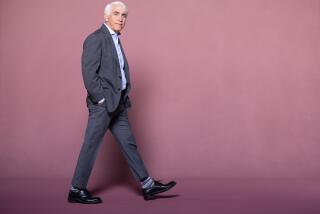Harley Baldwin, 59; Led Effort to Transform Aspen
Harley Baldwin, the jovial self-styled promoter, real estate developer and art dealer who helped put the international gleam on Aspen’s fabled Glitter Gulch, has died. He was 59.
Baldwin, who had homes in Aspen and Manhattan, died Jan. 23 at New York’s Memorial Sloan-Kettering Cancer Center of kidney cancer, according to his companion and sole survivor, Richard Edwards.
The owner of two key blocks in the Colorado ski resort’s historic district, Baldwin was landlord to designer boutiques, owner of Baldwin Gallery and impresario of the exclusive Caribou Club.
Baldwin scoffed at charges of fostering elitism even as he worked to attract high-end international tenants and clientele and transform Aspen from its folksy, hippie background into a glamorous enclave.
“Aspen is the No. 1 center in America for the world elite,” he told Vanity Fair in 2001. “Aspen is for the most successful people in the world. It so happens that they like to wear Gucci. Where’s the problem?”
The Chicago-born only child of an Air Force colonel, Baldwin grew up on bases from Hawaii to Massachusetts, earned a degree in international relations at Syracuse University and worked briefly as a welfare case worker and promotions director for Show magazine in New York.
But in 1968, then 23, Baldwin took his “family fortune of $1,200” and drove west to Colorado.
“I was a young man trying to set the sails,” he told People magazine in 1994. “I literally waited until I came to a turn in the road to decide where I was going.”
He sailed into Aspen, rented a trailer he later bought, invested $76 in pans and groceries and started selling crepes from the red Victorian-era Popcorn Wagon still seen on Aspen streets. Four months later, he bought a ranch and discovered a passion for real estate.
Baldwin dabbled in silver mining and, by 1971, had bought the 1891 Brand Building for less than $170,000. But he felt stymied by no-growth forces in Aspen, and, though he hung on to his Aspen properties, returned to New York. For 13 years, Baldwin pursued real estate interests there, including what became Bridgemarket food emporium under the Manhattan end of the Queensboro Bridge.
After returning to Aspen in 1988, he bought the Collins Block complex adjacent to his Brand Building and set about creating a two-block jewel for the city’s growing Glitter Gulch. Baldwin replaced a hardware store, mortuary and other businesses from Aspen’s homey past with shops for Christian Dior, Louis Vuitton, Gucci, Frette, Fendi and Brioni.
In the top floor, he developed his own 6,000-square-foot home, later featured in Architectural Digest. In the lower floor, he created the exclusive, members-only Caribou Club, which welcomed such celebrities as Frank Sinatra, Michael Douglas, Dennis Quaid, Diana Ross, Sylvester Stallone, Julia Roberts, Don Johnson and George Hamilton.
“Harley is what Aspen is all about,” Hamilton told People magazine in 1994. “He understands classic good taste and at the same time is irreverent about it.”
After Baldwin met Edwards, a London lawyer and art collector, he opened Baldwin Gallery a decade ago, raising Aspen’s art-world and cultural profile almost overnight.
“We’re twice the size of the Aspen Art Museum, and we do six times the business of most galleries,” Baldwin told Vanity Fair in 2001.
He owned nearly a dozen businesses in Aspen, including a boutique to sell the western-style silver belt buckles he designed.
Unsurprised when he sold the first two buckles to Michael Douglas, Baldwin provided an insight to his entrepreneurial philosophy when he told People: “I have an idea who my customer is. It’s not the cowboy. It’s the guy who owns the ranch.”
Baldwin served on boards of the Aspen Music Festival and the Aspen Community Foundation. He was a major contributor to the Aspen Gay & Lesbian Foundation and to the Democratic Party.
More to Read
Inside the business of entertainment
The Wide Shot brings you news, analysis and insights on everything from streaming wars to production — and what it all means for the future.
You may occasionally receive promotional content from the Los Angeles Times.










